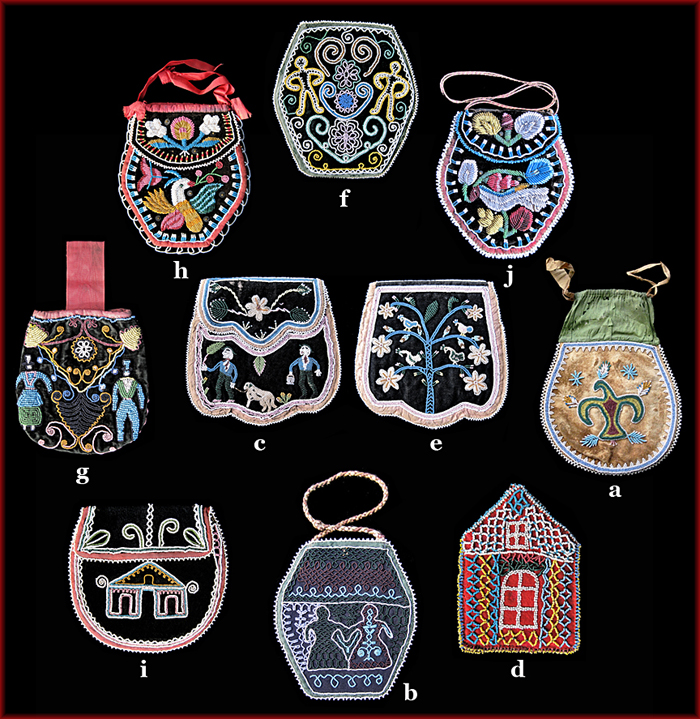Pictographic bags are of particular interest because of their scarcity among Northeast Woodland bags. One significant example is decorated with two identical figures that may represent the good and evil twins from the Haudenosaunee creation story (example f).
Arthur Parker characterizes some representations of the double-curve motif, in Iroquoian decorative arts, as the “celestial tree” that was created by the Good Twin (Parker 1912:613). Between the figures on the bag in example (f) are two large, inward turning curves with a sun-like symbol at its center. They may be symbolic expressions of the celestial tree and the world tree that Parker speaks of.
There is an ambiguous design on the back of the bag (not shown) that is suggestive of a face. Parker writes about the relationship between the Faces and the “world tree.”
This tree is mentioned in various ceremonial rites of the Iroquois. With the False Face Company … for example, the “Great Face,” chief of all the False Faces, is said to be the invisible giant that guards the world tree (Parker 1912:611).
Perhaps the design elements on the back side represent the “Great Face” that guards the world tree on the front. The shape of the mouth, formed by the lower two diamonds, is flattened like spoons, for blowing ashes, and is how the “Great Face” is sometimes depicted (see: Fenton 1987: plate 6-1).
This bag is a classic design that incorporates numerous elements of Haudenosaunee cosmology. The subtle and intricate designs, the limited use of motifs that are thoroughly filled with beads, silk inlays on the back side, and large areas of negative space all suggest a 1820s to 1830 date for this rare and exceptional piece.
Dogs were the only domesticated animals that were traditionally kept by Woodland Indians and many images exist of them with their dogs. However, no mention is made in the literature about the indigenous practice of using a leash (example c). Although depictions of Indians with their leashed dogs appear in other souvenir art pieces, this may have been done to appeal to the Victorians’ fondness for pets. Additionally, one of the subjects on this bag appears to be holding a purse or perhaps a basket.
The design on the back is somewhat cryptic (example e). Without the four birds, this motif could be interpreted as a flowering plant. The addition of the birds leaves little doubt that it was intended to represent a tree. However it’s not the classic celestial or world tree with the single flower/sun surmounted on the crown. Possibly the maker intended it to be a representation of the “Great Tree of Peace.” Traditionally, the white pine, with its five needles, was the symbol of the Five Iroquois Nations, joined together as one confederacy. But this tree has six branches so perhaps the maker was indicating with her design that since the Tuscarora were adopted into the confederacy that they were now the Six Iroquois Nations. The shape of the bag, with a scalloped flap and lower edge, is suggestive of the work of Caroline Parker.
Another intriguing bag has what appears to be two figures holding hands (example b). The negative space between them forms the shape of a heart. Adding to the mystery is the design inside the space of the right hand figure. The back of the bag (not shown) has a representation of a large, daisy-like flower.
The beaver pelt top hat was part of the formal dress of many Northeast Woodland people during the mid-nineteenth century. There are several nineteenth century prints and paintings that depict Native people wearing these hats. But extant examples of bags with figures wearing a top hat are exceptionally rare (example g). The figures in this piece typify the dress of two Natives from the period. In the enclosed space between the beehive-like motifs in the upper corners of this bag is a central sun design. The solidly beaded figures suggest that this piece is from the 1840s.
Perhaps the most novel example of a Northeast Woodland bag is one made in the shape of a house (example d). Here again, the impetus may have been the entrepreneurial spirit of the artist or it could have been a commissioned piece. Part of the mystery is the late nineteenth century Chinese silk lining, which is decorated with an embroidered bird. The beading style, and the bead colors used are atypical.
References:
Parker, Arthur C.
1912 - Certain Iroquois Tree Myths and Symbols in the American Anthropologist, Vol. 14
Fenton, William N.
1987 - The False Faces of the Iroquois – The University of Oklahoma Press – Norman, Publishing Division of the University.
